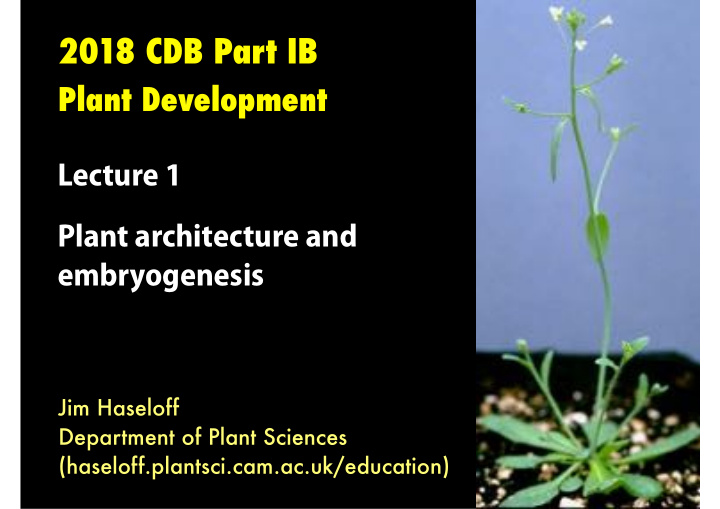



2018 CDB Part IB Plant Development Lecture 1 Plant architecture and embryogenesis Jim Haseloff Department of Plant Sciences (haseloff.plantsci.cam.ac.uk/education)
Plant Development Lecture 1: Plant architecture and embryogenesis. Lecture 2: Polarity and auxin fm ow. Lecture 3: Regulation of gene expression by auxin. Lecture 4: Patterning of indeterminate growth. Lecture 5: Formation and speci fj cation of lateral organs. Lecture 6: Morphogenesis. Web resources: An electronic version of the lecture slides, a colour version of these notes and additional teaching materials including review papers and essay topics can be found on the web site: http://haselo fg .plantsci.cam.ac.uk (click the “education” menu choice and navigate to the CDB Part 1B resources section). Recommended Text books: For an integrated overview of animal and plant development see: Principles of Development , Lewis Wolpert and Cheryll Tickle, Oxford University Press, 2011. Chapter 7 provides a concise overview of the lecture content. For coverage of plant development see: Mechanisms in Plant Development , Ottoline Leyser & Stephen Day, Blackwell Science, UK, 2002. For a general discussion of self-organisation across physical and biological systems see: Nature's patterns: a tapestry in three parts, Shapes, Flow and Branches , Phillip Ball, Oxford University Press, 2009.
Immobile and Branched
Plant cells are encased in a semi- rigid extracellular matrix
Plant Morphogenesis BBC Natural History Unit
Cladophora Origin of terrestrial plants
Coleochaete � 8
Colonisation of the land by plants
Different conditions faced by algae and plants Non supportive medium (air) Supportive medium (water) No photosynthesis in root cells Photosynthesis in most cells Aerial parts not in direct contact Direct access to minerals and water with minerals and water
! 11 400 mya
Early terrestrial plants Aglaophyton major
Distribution of terrestrial plants 390 million years ago
Arabidopsis thaliana as a model plant system
Arabidopsis thaliana has the best characterised plant genome.
1 cell embryo
4 cell embryo
Octant stage embryo
Radial asymmetry in the 16-cell embryo
Radial asymmetry in the 16-cell embryo Specification of shoot and root meristems
Protoderm stage embryo
Globular stage embryo
20,000 cells after 10 days of development
Arabidopsis thaliana germinating seed
Arabidopsis thaliana seeding 4 days after germination
A meristem is self-organising and renews itself.
The shoot meristem is branched and indeterminate, capable of producing lateral primordia at the flanks of the meristem.
Modular growth and production of lateral organs
Indeterminate growth of the Arabidopsis root meristem
Continued growth of shoot and root meristems produces the adult plant body
How is an adult body plan built? Precise sequence of divisions during early embryogenesis. Are plant cell fates controlled by (1) segregation of determinants? (2) positional information?
Genetic screening for mutants in Arabidopsis development
fass mutants have cytoskeletal defects, with altered patterns of cell division
fass alleles Wild type fass plants form organised tissues despite deranged cell divisions
Exchange of positional information
http://haseloff.plantsci.cam.ac.uk
Recommend
More recommend